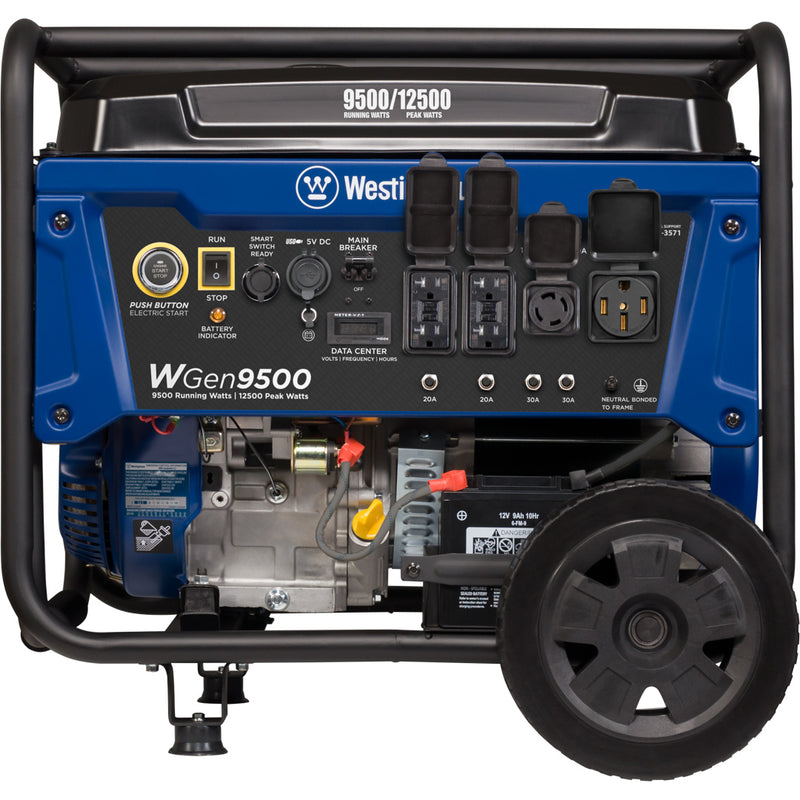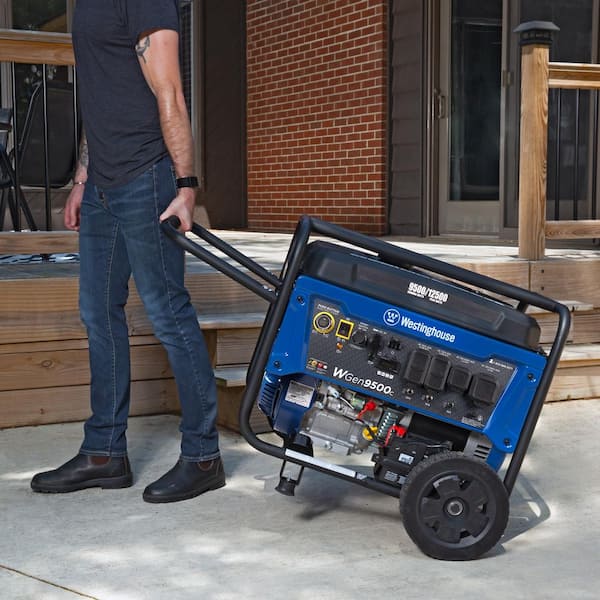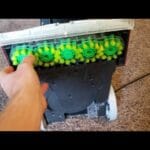Troubleshooting a Westinghouse Generator 9500 often starts with checking fuel levels and ensuring the oil isn’t low. Next, inspect the air filter and spark plug for potential issues.
Generators are pivotal in providing power during outages, making the Westinghouse Generator 9500 a popular choice for its reliability and efficiency. Yet, like all machinery, it can encounter issues. Understanding the common problems and how to address them swiftly can prevent prolonged downtime.
From ensuring regular maintenance to knowing the basics of troubleshooting, keeping your generator in top condition is essential. This brief guide aims to equip you with the knowledge to tackle common problems, ensuring your Westinghouse Generator 9500 remains a dependable source of power. Remember, routine checks and timely troubleshooting can significantly extend the life of your generator, making it ready to serve when you need it most.

Credit: www.youtube.com
Introduction To Westinghouse Generator 9500
Reliable power is a must in our daily lives. The Westinghouse Generator 9500 emerges as a robust solution. It ensures a steady electricity supply during outages. This generator is a blend of power, efficiency, and convenience. It caters to a variety of needs, both at home and in industries.
Features At A Glance
- Peak Watts: 12,500
- Running Watts: 9,500
- Engine: 457cc, 4-Stroke OHV
- Fuel Type: Gasoline
- Run Time: Up to 17.5 hours
- Outlets: Multiple, including transfer switch ready
- Remote Start: Included
- Portability: Solid wheels and handles
Common Uses In Home And Industry
| Home Use | Industry Use |
|---|---|
| Emergency power | Job sites |
| Appliances | Power tools |
| Electronics | Events |
| Heating and cooling | Agriculture |
Starting Issues
When your Westinghouse Generator 9500 won’t start, it’s often a fuel or battery issue. We’ll walk through each possibility step by step. Remember to perform these checks safely and according to your generator’s manual.
Checking The Fuel System
Is your generator low on fuel? It seems simple, but it’s a common oversight. If your generator has enough fuel, the next step is to check for blockages. Look at the fuel lines and filter. A clogged filter can prevent fuel from reaching the engine. Replace it if necessary. Next, check the carburetor. It might need cleaning or adjustment.
- Ensure the tank has fuel
- Examine fuel lines for clogs
- Replace dirty fuel filters
- Clean or adjust the carburetor
Inspecting The Battery And Connections
A weak or dead battery is a common culprit. First, check the battery’s charge level. Use a multimeter if available. It should read above 12 volts. Next, inspect the terminals. Clean off any corrosion with a wire brush. Ensure all connections are tight and secure. Sometimes, the problem is a blown fuse or tripped breaker. Check these components and replace or reset as needed.
- Test the battery’s charge level
- Clean battery terminals
- Secure all connections
- Replace blown fuses
- Reset tripped breakers
Electrical Output Problems
Having trouble with your Westinghouse Generator 9500’s electrical output? You’re not alone. Many users face issues where their generator doesn’t produce power properly. But don’t worry, we’ll guide you through some common troubleshooting steps to get your generator back in action.
Testing Voltage And Frequency
First, let’s check the generator’s voltage and frequency. These are key to smooth operation. Use a multimeter for this task. Here’s how:
- Turn off all loads connected to the generator.
- Start the generator and let it run for a few minutes.
- With your multimeter set to measure AC voltage, check the output at the generator’s outlets.
- Expect a reading of around 120 volts for a standard outlet.
- To check frequency, switch your multimeter to Hz settings. The generator should show close to 60 Hz.
If readings are off, the generator might need a professional adjustment or repair.
Examining Circuit Breakers And Connections
Next, inspect the generator’s circuit breakers and connections. These parts can loosen over time or trip during use. Here’s what to do:
- Ensure the generator is off and cool to the touch.
- Locate the circuit breakers on the generator. They’re usually marked.
- Check if any breakers are tripped (in the OFF position). If so, reset them by flipping to ON.
- Inspect all cable connections. Tighten any loose connections you find.
Loose or damaged connections can cause power issues. Always handle electrical parts carefully.
Engine Performance Hiccups
Generators like the Westinghouse 9500 can experience engine hiccups. These affect performance. Regular maintenance keeps engines running smoothly. Let’s explore common issues and fixes.
Air Filter Maintenance
A clean air filter is vital for a healthy engine. A dirty filter can cause hiccups. Check and clean your air filter regularly to avoid this.
- Turn off the generator.
- Remove the air filter cover.
- Take out the filter.
- Clean with soapy water or replace if needed.
- Let it dry completely before reinstalling.
Spark Plug Condition Checks
Spark plugs ignite the fuel in your generator. A faulty spark plug causes poor performance. Inspect and change spark plugs when needed to keep your engine hiccup-free.
- Locate the spark plug on your generator.
- Disconnect the spark plug cap.
- Use a spark plug socket to remove the plug.
- Check for deposits or damage.
- Replace with a new spark plug if necessary.
- Reconnect the spark plug cap securely.
Regular checks ensure your generator runs efficiently. Follow the manufacturer’s guidelines for specific maintenance schedules.
Fuel System Complications
Generators need fuel to run. Sometimes, they act up. Your Westinghouse Generator 9500 is no different. Fuel issues are common. They can stop your generator cold. Let’s fix that. We’ll look at the carburetor and fuel quality. Both are key to a smooth-running engine.
Cleaning The Carburetor
A dirty carburetor causes trouble. It can block fuel flow. Your generator might start then stop. Or maybe it won’t start at all. Cleaning the carburetor is a fix. Here’s how:
- Turn off the generator.
- Remove the carburetor.
- Disassemble it carefully.
- Clean each part with carb cleaner.
- Reassemble and reattach it.
After cleaning, your generator should run smoother. If not, a professional might need to check it.
Fuel Quality And Storage
Fuel goes bad over time. Bad fuel won’t burn well. It can even harm your generator. Here’s what to do:
- Use fresh fuel: Don’t use old gas.
- Store properly: Keep fuel in a cool, dry place.
- Add stabilizer: This keeps fuel fresh longer.
Remember to empty old fuel from the generator before storing it. This helps prevent issues when you need it next.
Control Panel Glitches
Control Panel Glitches can stop your Westinghouse Generator 9500. These issues may seem big but are often easy to fix. Let’s dive into common glitches and how to solve them.
Resetting The System
Resetting can fix many problems. Follow these steps:
- Turn off the generator.
- Wait for a few minutes.
- Turn it back on.
This simple reset can clear glitches. It’s like a fresh start for your generator.
Panel Display Errors
Errors on the display can confuse. They tell you something is wrong. Here’s what to do:
- Check the manual for error codes.
- Look for simple fixes like loose cables.
- If unsure, contact customer support.
Always refer to the manual first. It has specific solutions for your model.
Noise And Vibration Issues
Generators are life-savers during power outages. But, they can sometimes make strange noises or vibrate too much. Let’s explore how to fix these problems with a Westinghouse Generator 9500.
Isolating Unusual Noises
If your generator makes odd sounds, don’t worry. First, check if something’s loose. Tighten screws and bolts. Look for any signs of wear or damage. Replace worn parts immediately.
Listen to where the noise comes from. Is it the engine, exhaust, or alternator? Use the manual to identify parts. It will guide you.
Remember: Always turn off the generator before inspecting. Safety first!
- Check the exhaust system for leaks.
- Inspect the air filter for clogs.
- Ensure the oil level is correct.
- Look at the spark plug for dirt or damage.
Reducing Vibration
Too much shaking is not good. It can harm your generator. First, place the generator on a flat surface. Make sure it’s stable.
Use anti-vibration mounts. These rubber parts absorb shakes. They keep the generator steady. You can find them at hardware stores.
Check the engine mount bolts. Are they tight? If not, tighten them. But don’t overdo it. Bolts can break if they’re too tight.
Tip: Regular maintenance reduces vibration. Follow the service schedule in your manual.
Here’s a checklist to keep vibrations low:
| Action | Benefit |
|---|---|
| Balance the alternator and fans. | Prevents wobbling. |
| Secure loose components. | Stops rattling noises. |
| Replace damaged engine mounts. | Keeps engine in place. |

Credit: westinghouseoutdoorpower.com
Maintenance Tips
Keeping your Westinghouse Generator 9500 running smoothly requires regular upkeep. Maintenance ensures efficiency and longevity. Follow these tips to avoid common issues and extend your generator’s life.
Regular Service Intervals
Maintain your generator with these steps:
- Check oil levels before each use.
- Replace oil after first 20 hours of use.
- Service every 100 hours or once per year.
- Inspect air filter monthly; clean or replace as needed.
- Examine spark plugs for wear; replace if necessary.
Long-term Storage Advice
Store your generator properly with these tips:
- Run the engine until it uses all the fuel.
- Disconnect the spark plug wire.
- Drain all oil from the engine.
- Clean the exterior and apply a protective spray.
- Store in a cool, dry place.
Follow this guide to keep your generator ready for emergencies.
Professional Help And Support
Professional Help and Support is crucial when your Westinghouse Generator 9500 faces issues beyond basic troubleshooting. Sometimes, the problems are technical and require a skilled hand. Knowing when to call a technician can save time and ensure your generator runs smoothly.
When To Call A Technician
Generator malfunctions might stump even the handiest individuals. Look for these signs:
- Strange noises like grinding or clanking
- Electrical failures that reset doesn’t fix
- Oil leaks or unusual smells
- Failure to start, despite correct procedures
Don’t hesitate to seek professional help if you encounter these problems. Experts have the right tools and knowledge.
Warranty And Customer Service Information
Understanding your warranty can save money on repairs. Westinghouse offers a robust warranty for generators, covering parts and labor for specific periods. Check your user manual or warranty card for details. For active warranties, contact customer service:
| Contact Method | Details |
|---|---|
| Phone | 1-855-944-3571 |
| customerservice@westinghouse.com | |
| Online Support | Visit www.westinghouse.com/support |
Westinghouse’s customer service team provides guidance, and they can direct you to authorized service centers. Keep your generator’s model and serial number handy when you call or email. This helps the team assist you better.

Credit: www.homedepot.com
Frequently Asked Questions
Why Is My Westinghouse Generator 9500 Not Starting?
A possible cause could be a fuel supply issue or a faulty spark plug. Ensure fuel is fresh and the spark plug is clean and correctly gapped.
What Does E6 Error On Westinghouse 9500 Mean?
The E6 error indicates a fault in the generator’s control system. Check the manual for specific troubleshooting steps or contact customer support.
How To Reset Westinghouse 9500 Generator?
To reset, turn off the generator, disconnect all loads, wait for it to cool down, and then restart following the user manual instructions.
Can I Run My Westinghouse 9500 Continuously?
Continuous operation is possible, but regular maintenance intervals as per the user manual must be followed to prevent overheating or damage.
How To Resolve Fuel Leakage In Westinghouse 9500?
Inspect the fuel lines for damage or looseness and replace them if necessary. Ensure all connections are secure and the fuel cap is properly sealed.
What Maintenance Does Westinghouse 9500 Require?
Regular maintenance includes checking oil levels, cleaning or replacing air filters, and inspecting spark plugs and fuel lines as per the maintenance schedule in the user manual.
Conclusion
Navigating the intricacies of the Westinghouse Generator 9500 can be daunting. Yet, with this guide, troubleshooting becomes less intimidating. Tackle common issues using our tips and keep your generator running smoothly. Remember, regular maintenance is key to longevity and performance.
For further assistance, consult the user manual or a professional technician. Stay powered up, safely and efficiently.




